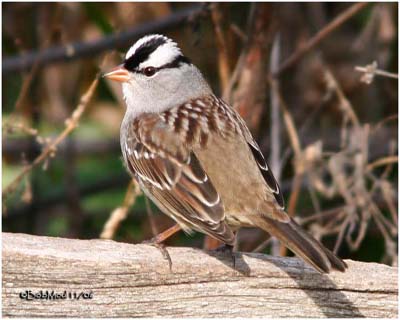
White-crowned Sparrow
Zonotrichia leucophrys
Passeriforme Order – Passerellidae Family
BIOMETRICS:
Length : 15-16 cm
Wingspan : 21-24 cm
Weight : 25-28 g
LONGIVITY: up to 13 years
DESCRIPTION:
White-crowned sparrow is a large sparrow but a small songbird.

Adult is unmistakable, having unmarked ash-grey sides of head, throat and breast, becoming white on belly, and pale brownish-buff on flanks, head pattern striking with bright white median crown-stripe and supercilium, black crown sides, eye-stripe and lores, and mainly pinkish bill. White-crown feathers often fluffed up into a low ruffled dome. Legs are brown to pink. Eyes are dark.
Both sexes are alike in plumage. Male is slightly larger.
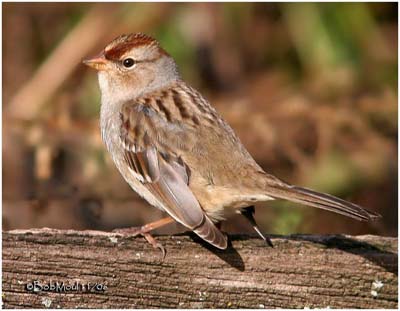
First winter has duller and browner, although still striking head pattern.
We can find five subspecies such as Zonotrichia leucophrys pegetensis, Z. l. gambelli, Z. l. nuttali, Z. l. oriantha and Z. l. leucophrys. They differ by their migratory behaviour and breeding areas.
VOICE: SOUNDS BY XENO-CANTO
White-crowned Sparrow’s call includes an abrupt, rather metallic “chink” or “pink”, and a thin, high ‘tseep”.
Song is variable, with one or two clear whistled notes, followed by two or three drier, and often more trilled notes.
Males on the edge of two dialects may be bilingual and able to sing both dialects.
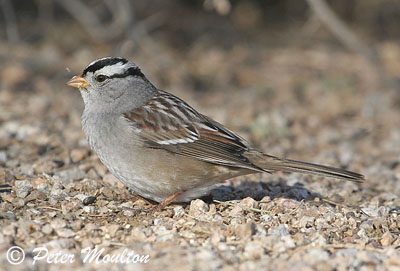
HABITAT:
White-crowned Sparrow breeds in a wide variety of shrubby habitats, including open woodlands, bushy thickets, stunted conifers, bushy tundra, mountain shrubbery, parks and gardens.
RANGE:
White-crowned Sparrow breeds from Alaska eastward across northern Canada, and southward along Pacific coast, and in the western mountains to southern California and northern New Mexico.
It winters from southern British Columbia eastward to southern Michigan and southern New York, southward to the Gulf Coast and Central Mexico.
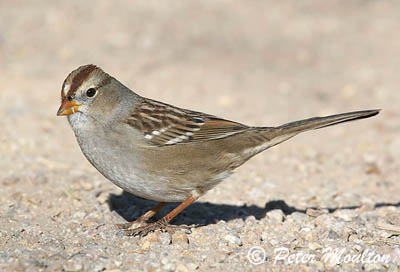
BEHAVIOUR:
White-crowned Sparrow feeds mostly on ground. It scratches in litter with both feet. It may hawk some insects from perch.
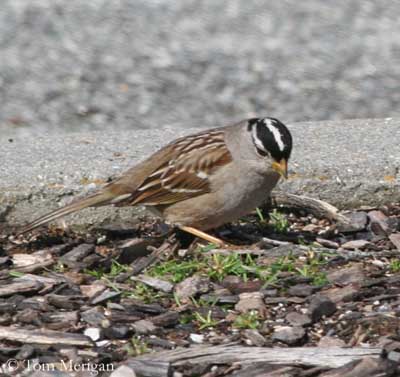
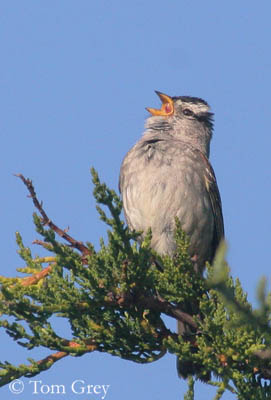
Four of the five subspecies of White-crowned Sparrows are migratory. Sedentary race lives in a narrow band along California coast. It travels in small group of about 8 birds during migration.
Males are highly territorial. They return every year on the same established territory. When an intruder or predator enters into it, male puffs up its chest, holds up its crown feathers, and sing very loudly. Fighting is common when the male is first settling into its territory during the breeding season.
White-crowned Sparrows are monogamous and mate for life. Male does not perform courtship feeding, but wait until female starts courtship. She bows with her head arched, and parts her tail feathers to expose the cloacae. Male responds by raising its crown feathers, lowering its spread tail feathers, and standing on her back for about three seconds before flying off.
To avoid uncovering their nest, White-crowned Sparrows fly towards their nest, but stop short by a few metres and travel the rest of the way walking. Female may do a distraction display by wagging her tail feathers, and running away from the nest.
White-crowned Sparrow feed on ground in open, but usually not far from cover into which it retreats when alarmed.
FLIGHT:
White-crowned Sparrow will fly back to cover if disturbed while it is feeding.
REPRODUCTION:
White-crowned Sparrow’s nest is built in the ground cover, or hidden in a clump of vegetation, or less commonly, at the base of a tree or among tree roots or beside a rock or log. Nest is built only two or three weeks after male and female have arrived on breeding grounds. It’s cup-shaped, made with small sticks, bark, grass, pine needles or dry leaves, and lined with fine grass stems, sedge and hair. Nest is placed in shrubs or on ground.
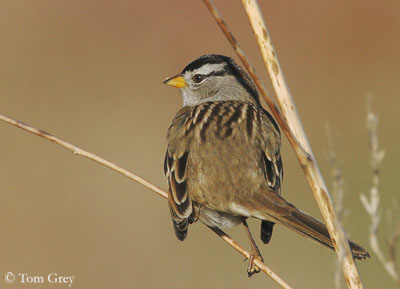
Female lays 3 to 7 greenish blue eggs with reddish brown spots. Incubation lasts about 12 days, by female. She develops a brood patch during the nest construction, to make the process more efficient. During incubation, female turns the eggs, and leaves the nest during the day to forage for her. When eggs are hatched, male brings food, contributing to feeding the young as they mature.
Young are born naked except for a few down feathers on their transparent pink body. They fledge at about 10 days, and reach their adult weight when they are 30 to 35 days old.
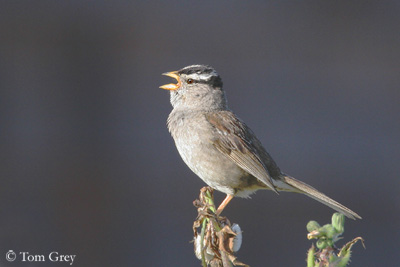
DIET:
White-crowned Sparrow consumes primarily plant matter such as seeds, buds, grass and fruit. During spring, they eat mainly insects and seeds.
PROTECTION / THREATS / STATUS:
White-crowned Sparrow is uncommon, but known, cowbird host.
Fr: Bruant à couronne blanche
All : Dachsammer
Esp: Sabanero de Corona Blanca
Ital: Passero corona bianca
Nd: Witkruingors
Russe: Белобровая овсянка
Sd: Vitkronad sparv
Photographs by Bob Moul
His website: Nature Photography
Photographs by Peter Moulton
His web site : Pete Moulton Photography
Photograph by Tom Merigan
His website: Tom Merigan’s Photo Galleries
Photographs by Tom Grey
His website: Tom Grey's Bird Pictures
Text by Nicole Bouglouan
Sources :
FIELD GUIDE TO THE BIRDS OF NORTH AMERICA - National Geographic Society - ISBN: 0792274512
THE HANDBOOK OF BIRD IDENTIFICATION FOR EUROPE AND THE WESTERN PALEARCTIC by Mark Beaman, Steve Madge - C.Helm - ISBN: 0713639601
All About Birds (Cornell Lab of Ornithology)
Bird Web (Seattle Audubon Society)
What Bird-The ultimate Bird Guide (Mitchell Waite)
Wikipedia (Wikipedia, The Free Encyclopedia)
Animal Diversity Web (University of Michigan Museum of Zoology)
Eastern form
Black lores
Pinkish bill
Eastern form - Juvenile
Black lores
Pinkish bill
Gambel's subspecies
Grey lores
Orange bill
Gambel's subspecies: Juvenile
Grey lores
Orange bill
Gambel's subspecies
Grey lores
Orange bill
Gambel's subspecies
Grey lores
Orange bill
Gambel's subspecies
Grey lores
Orange bill
Gambel's subspecies
Grey lores
Orange bill